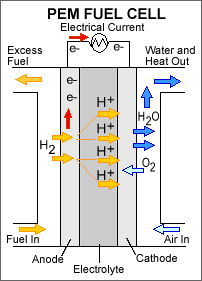What is the technology behind hydrogen fuel cells?

A hydrogen fuel cell combines hydrogen from a tank and oxygen from the air to produce electricity which powers the motor vehicle and releases water vapour. Electricity is generated for as long as hydrogen is supplied, it does not rely on a charge like a battery.
The test is to make the fuel cell economical, light and resilient yet powerful enough to power the engine as well as other essential features such as the lights and even the air conditioning!
As the image on the left illustrates, a fuel cell comprises of two electrodes; an anode (positive) and a cathode (negative). Between them lies an electrolyte membrane and a platinum catalyst is often used. Oxygen gas passes over the cathode and hydrogen over the anode that subsequently generates electricity, water and heat.
Within the vehicle there must be a fuel tank containing enough hydrogen for the vehicle to travel several hundred kilometers before reaching a refueling station. In California, there are already 24 refueling stations most commonly found within the Los Angeles area.
The test is to make the fuel cell economical, light and resilient yet powerful enough to power the engine as well as other essential features such as the lights and even the air conditioning!
As the image on the left illustrates, a fuel cell comprises of two electrodes; an anode (positive) and a cathode (negative). Between them lies an electrolyte membrane and a platinum catalyst is often used. Oxygen gas passes over the cathode and hydrogen over the anode that subsequently generates electricity, water and heat.
Within the vehicle there must be a fuel tank containing enough hydrogen for the vehicle to travel several hundred kilometers before reaching a refueling station. In California, there are already 24 refueling stations most commonly found within the Los Angeles area.
